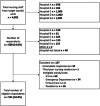Ethics, orthodoxies and defensive practice: a cross-sectional survey of nurse's decision-making surrounding CPR in deceased inpatients without Do Not Resuscitate orders
- PMID: 40394513
- PMCID: PMC12090638
- DOI: 10.1186/s12910-025-01224-2
Ethics, orthodoxies and defensive practice: a cross-sectional survey of nurse's decision-making surrounding CPR in deceased inpatients without Do Not Resuscitate orders
Erratum in
-
Correction: Ethics, orthodoxies and defensive practice: a cross-sectional survey of nurse's decision-making surrounding CPR in deceased inpatients without Do Not Resuscitate orders.BMC Med Ethics. 2025 Aug 30;26(1):114. doi: 10.1186/s12910-025-01281-7. BMC Med Ethics. 2025. PMID: 40885992 Free PMC article. No abstract available.
Abstract
Background: In hospital, nurses are often the first to identify patients in cardiorespiratory arrest and must decide whether to call a CODE BLUE and commence cardiopulmonary resuscitation (CPR). In Australia, there are no legal or policy obligations to commence CPR when unequivocal signs of death are present. The use of CPR where it cannot provide any benefit to a patient raises profound questions about decision-making and ethical practice. The aim of this empirical ethics study was to describe hospital-based nurses' decision-making, perspectives, and experiences of initiating CPR in hospitalised patients who have unequivocal signs of death but lack a Do-Not-Resuscitate (DNR) order.
Methods: The study was a multisite cross-sectional descriptive survey conducted between October 2023-April 2024. Nurses were presented with two clinical scenarios in which patients were found to have no signs of life: Mr. D, an 84-year-old male with cancer, and Mr. G, a 35-year-old male post-motor vehicle accident. Eligible participants were all nurses working in in-patient units. Descriptive statistics, Pearson Chi-square or Fisher's exact tests, McNemar test, and binomial logistic regression were used to analyse the data.
Results: 531 nurses completed the survey. For Mr D, 61.5% (n = 324) would call a CODE BLUE, 24.1% (n = 127) would perform limited CPR. Only 14.4% (n = 76) would confirm death. For Mr G, 93.9% (n = 492) would call a CODE BLUE, 4.4% (n = 23) would perform limited CPR, and 1.7% (n = 9) would confirm death. The major reasons why nurses initiate a CODE BLUE were 'In the absence of an DNR order, there is no option but to begin CPR', 'I am required by hospital policy to do so', 'I am required by law to do so' and 'It is what I was trained to do'.
Conclusions: Most nurses would commence CPR in patients with clear signs of death in the absence of a DNR order. This seems most likely related to ignorance or misunderstanding of law, policy and/or the misapplication or professional norms. These results raise important questions about the drivers of nurses understanding of and engagement with CPR. This highlights ethical concerns for care and treatment of patients at the end of their life and underscores the need to examine ethical practice, agency, and professionalism and supports review of policy, practices and education regarding ethical end-of-life decision making and care.
Keywords: Cardiopulmonary resuscitation; Cross-Sectional studies; Decision making; Defensive medicine; Ethics; Nursing; Resuscitation orders.
© 2025. The Author(s).
Conflict of interest statement
Declarations. Ethics approval and consent to participate: The study protocol was approved by the South Eastern Sydney Local Health District (SESLHD) Human Research Ethics Committee (HREC) (Reference: 2023_ETH01759) and was conducted in accordance with the Declaration of Helsinki. All participants were advised via the Participant Information Sheet (PIS) that completion of the survey constituted implied informed consent as per the ethics approval. Consent for publication: All participants gave implied informed consent for participation and for all data to be reported in publications as per the ethics approval. Competing interests: The authors declare no competing interests.
Figures
Similar articles
-
Prescription of Controlled Substances: Benefits and Risks.2025 Jul 6. In: StatPearls [Internet]. Treasure Island (FL): StatPearls Publishing; 2025 Jan–. 2025 Jul 6. In: StatPearls [Internet]. Treasure Island (FL): StatPearls Publishing; 2025 Jan–. PMID: 30726003 Free Books & Documents.
-
A rapid and systematic review of the clinical effectiveness and cost-effectiveness of paclitaxel, docetaxel, gemcitabine and vinorelbine in non-small-cell lung cancer.Health Technol Assess. 2001;5(32):1-195. doi: 10.3310/hta5320. Health Technol Assess. 2001. PMID: 12065068
-
Sexual Harassment and Prevention Training.2024 Mar 29. In: StatPearls [Internet]. Treasure Island (FL): StatPearls Publishing; 2025 Jan–. 2024 Mar 29. In: StatPearls [Internet]. Treasure Island (FL): StatPearls Publishing; 2025 Jan–. PMID: 36508513 Free Books & Documents.
-
Interventions for supporting pregnant women's decision-making about mode of birth after a caesarean.Cochrane Database Syst Rev. 2013 Jul 30;2013(7):CD010041. doi: 10.1002/14651858.CD010041.pub2. Cochrane Database Syst Rev. 2013. PMID: 23897547 Free PMC article.
-
The Black Book of Psychotropic Dosing and Monitoring.Psychopharmacol Bull. 2024 Jul 8;54(3):8-59. Psychopharmacol Bull. 2024. PMID: 38993656 Free PMC article. Review.
Cited by
-
Correction: Ethics, orthodoxies and defensive practice: a cross-sectional survey of nurse's decision-making surrounding CPR in deceased inpatients without Do Not Resuscitate orders.BMC Med Ethics. 2025 Aug 30;26(1):114. doi: 10.1186/s12910-025-01281-7. BMC Med Ethics. 2025. PMID: 40885992 Free PMC article. No abstract available.
References
-
- Kapoor MC. The History and Evolution of Cardiopulmonary Resuscitation. Resuscitation. 2024;1(1):3–9.
-
- Thomas TA, McCullough LB. Resuscitations That Never End: Originating From Unresolved Integrity-Related Moral Distress. JAMA Pediatr. 2016;170(6):521–2. - PubMed
Publication types
MeSH terms
LinkOut - more resources
Full Text Sources
Medical
Miscellaneous



